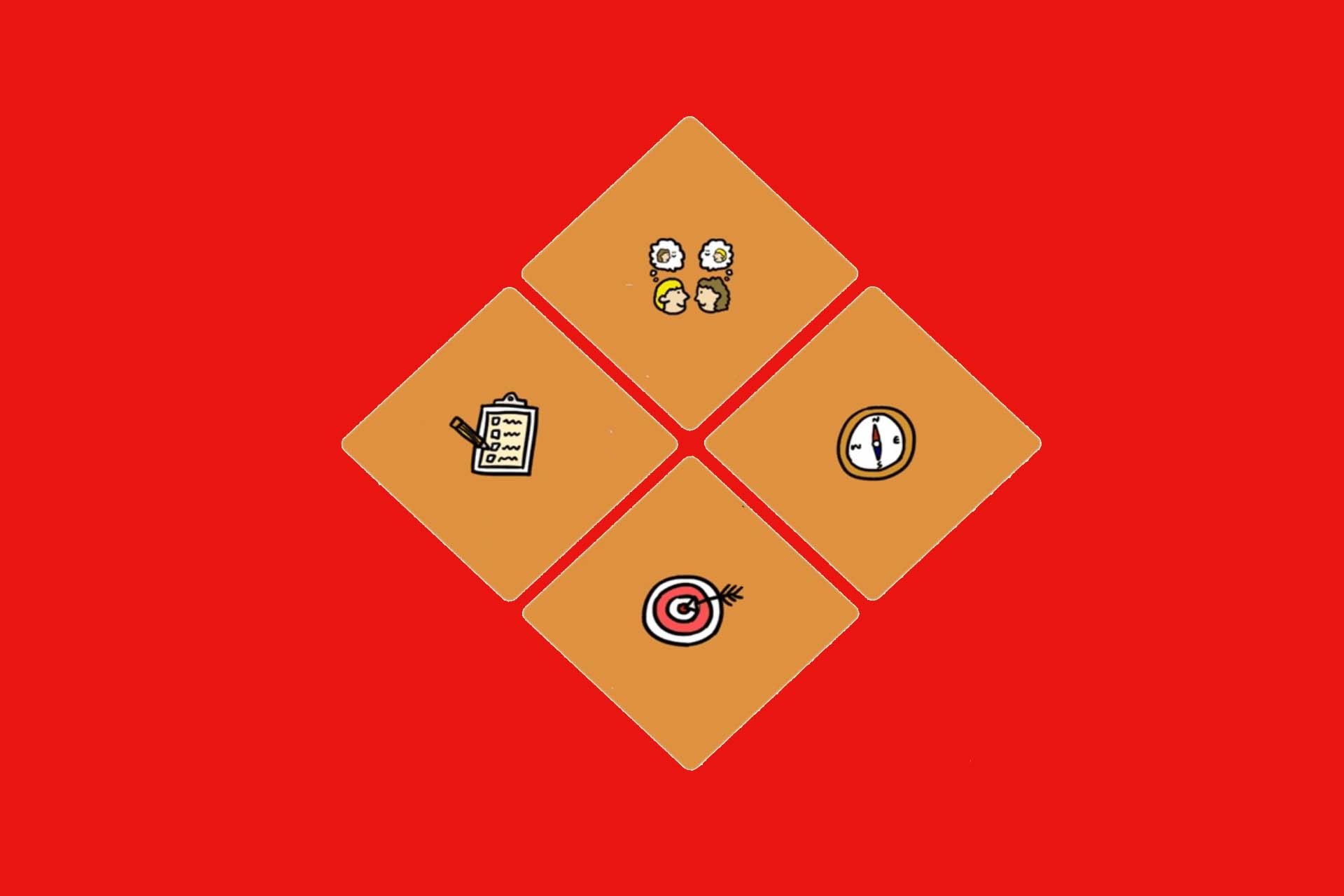Consensus, consent or what?
How we get to good decisions as a team!
Making a decision is often difficult enough when you have to make it on your own. You just have to come to an agreement with yourself.
But how do I come to a decision in a team? A decision with which everyone can live well and which everyone can support afterwards? More people bring in more perspectives, the pros and cons can be more valuable and more strenuous. The most important question for me is how a team can learn to make good decisions together.
Psychology of decision making
The difference between good and less good team decisions is not the decision itself but the approach taken. The way decisions are made. How they are communicated. How the decisions are dealt with. This is what determines the culture in the team, and this is what makes or breaks the entire performance. Why? Because decisions – like all other communication acts – have two levels.
- On the factual level it is about solving a problem, the answer to a question, a small piece of the puzzle of how to shape the future.
- On the relational level it is about how the opinion of each individual person involved in the decision or affected by the decision is dealt with, with the needs and sensitivities behind it. The degree and nature of their consideration pays into the accounts security, trust, respect, appreciation and has very clear consequences for commitment.
In Maslow’s hierarchy of needs1, security and social needs are the prerequisite for self-development and engagement. Accordingly, Lencioni2 sees trust in the team and the ability to deal with differences of opinion in an appreciative manner as prerequisites for commitment and the assumption of responsibility. And according to Watzlawick’s Axiom #2, the quality of the relationship level determines how we deal with information on the factual level3.
So the way we deal with “dissenting opinions” or more correctly with people with “dissenting opinions” decides how they later implement a decision that is not or not entirely theirs.
What is the practical consequence of this long preface?
Consensus
For consensus, i.e. the approval of a decision, democratic majority voting is a frequently used method. Those who do not want chaotic discussion or the manipulating influence of individuals in this process usually resort to structuring tools that help to systematise the discussion and even make it possible to do so remotely. Acceptify.at4 is such an interesting tool to collect, question, comment and evaluate ideas. At the end a group ranking is created. This is the factual side of the decision. Such a formalising tool can also remove tension from the process, which brings us to the emotional side.
Now it gets tricky. If, at the beginning, we unanimously make the fundamental decision that we do not need unanimity for certain issues in the future, but that majority decisions are sufficient, then everyone accepts to support 100% even those decisions that do not correspond to their position.
If, however, we have not unanimously adopted this decision of principle, but only by a majority, we automatically produce losers. By doing so, the majority of the team ignores the wish of a minority to decide particularly important issues only unanimously and not against the wishes of individuals. An additional possible veto right for hardship cases is only the confrontational variant of a unanimity rule, which safeguards needs but damages relationships. You only have to imagine the emotional tension with which you would lift your veto card and how the others would look.
Consent
Decisions can also be made the other way round. One does not choose the proposal with the most votes in favour, but the one with the fewest rejections. This rarely results in the same outcome and the decision “the fewest have something against it” is on a broader and more emotionally stable basis.
One step further in the direction of a well-founded joint decision is the subsequent discussion of concerns and objections, until a solution is found against which nothing more is brought forward.
The procedure comes from the sociocratic world, is called consent, and means approval, acceptance. Unfortunately, the word consent does not create a differentiating image in my mind, which is bad for the visualising internalisation of the term and the procedure. With “consensus” I see nodding people or thumbs up – and with “consent”?
What can still disturb the procedure in terms of relationship is the fact that, with one’s concerns and objections, one is first of all against the proposals of others in order to then develop a common solution. The state of mind of the one is directed against the solution idea of the other. This does not always leave its mark on the relationship level.
Red Circle Solution
A better result is achieved if the two elements “personal sensitivities of individuals” and “controversial discussion of solutions” are separated.
In the first step, all participants formulate – not discuss – their needs and sensitivities in connection with the problem to be clarified, without already mentioning a concrete solution. It is “only” about the individual “musts & must nots”.
Summarised and detached from the individual persons, they represent the framework within which, in a second step, a positive solution can be sought that fits these framework conditions.
Metaphorically speaking, everyone stands at a bold red circle and looks at each other. Behind them lies the non-negotiable area of the needs to be protected, in front of them in the circle is the pool of possible solutions. I call this – nomen est omen – “Red Circle Solution”. Here, too, you can work with the tool from acceptify.at. It is important to ask the right questions.
Not: Which software do we want to work with?
But rather: What do I want to do with the tool, what must it be able to do, what is important to me? What must not happen when working with the tool?
Error or learning culture?
What if the decision makers were wrong, if the decision was wrong? The pressure can be reduced by not looking for the ultimate right solution. Instead, decisions are seen as hypotheses about the best course of action at the moment, which is tested over a fixed period of time. Success is tested, the framework conditions are monitored and, if necessary, and in any case by a fixed date, a new decision is made on how to proceed. This is not simply a prolongation of the decision, it is a reassessment of the situation.
Such an approach would be good for all decision-making processes. Revising ultimate decisions always results in the stigma of a mistake and often a loss of face for the original decision-maker. Temporary decisions with an expiration date can be optimised again and again without the scrutiny of any of the parties involved; learning has only one positive component.
The method works even when the fronts are hardened. Either the work on the Red Circle confirms completely conflicting interests, in which case the problem lies somewhere else entirely. Or the method helps to find hidden common ground or acceptable individual wishes.
Morphological Matrix
The remaining question is how to achieve a concrete solution with the “Red Circle Solution”. Here I propose the morphological box. The trick of this box is to break down the creative process of finding a solution.
Example: Develop a new bicycle!
Now, if everyone takes pen and paper and scribbles a new bicycle, then they probably have a few classic bicycles in mind and vary them.
In the creativity technique “Morphological Matrix” the bicycle is first divided into functional elements:
- number of riders,
- sitting position,
- drive type,
- number and arrangement of the wheels,
- design of the wheels,
- material of frame and wheels,
- type of use and whatever else comes to mind.
Secondly, all sections are filled with ideas independently of each other, without thinking about the finished bike, but only about the variations of the respective detail.
Only in the third step we play through arbitrary combinations and see what can be made of them. And probably more than just a new bicycle idea will emerge. The individual ideas now only have to be compared with the previously developed wishes and ideas.
In the same way, the morphological matrix can also be used for needs and sensitivities with subsequent solution finding.
Notes (mostly in German):
You can learn more about decision communication in David Marquet’s book “Leadership is Language“.
[1] Die Bedürfnispyramide von Maslow verstehen und anwenden
[2] 5 Erfolgsmerkmale eines Teams (nach Lencioni)
[3] Axiome von Paul Watzlawick
[4] Acceptify.at
Conrad Giller has published another post on the t2informatik Blog:

Conrad Giller
Conrad Giller has been working for about 30 years as a trainer, coach and consultant for almost all challenges of oral communication: conflict, team, leadership, storytelling, presenting, moderating, media, etc. He is happy to pass on his experience online and offline in workshops.


